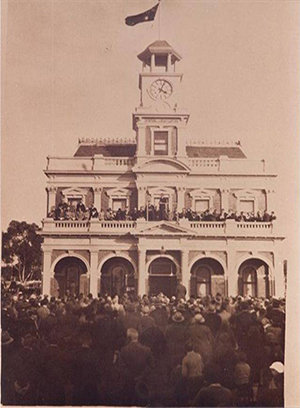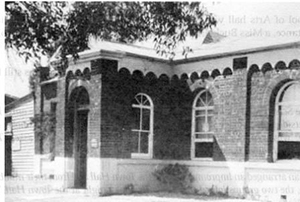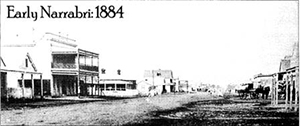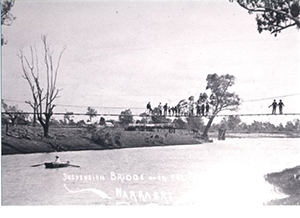 Brief Overview
Brief Overview
It is apt that the town's name is said to mean 'forked waters'. As you drive through Narrabri along the highway you will notice this splintering of the waterways. First you pass over the Namoi River, then Narrabri Creek and, finally, the creek's sub-branch, Horse Arm Creek.
The name presumably derives from the language of the Kamilaroi tribe who were the original occupants. In 1818 John Oxley became the first European to set foot in the district. Allan Cunningham explored the Boggabri Plains in 1825 and escaped convict George Clarke roamed what is now Narrabri Shire from 1826-1831. His tales of a vast inland river prompted the expedition of Thomas Mitchell into the district, thereby opening it up to settlement.
The first squatting run was the 'Nurrabry', taken up in 1834. A town site was first recommended in 1848 at what had become a road junction to the south and west. A hotel was licensed in 1858 and the town was proclaimed in 1860. A post office and police station were established but a major flood devastated the township in 1864.
An early sign of the town's importance was the transfer of court services from Wee Waa and the building of a courthouse in 1864-65. A coach service commenced in 1865 and the first public school opened in 1868.
After the Robertson Land Act of 1861 the area was slowly opened up to smaller selectors and wheat-growing began in 1873. Consequently the population climbed from 313 in 1871 to 1 977 in 1891. The growth in size and prosperity of the town is evident, if one compares the two surviving courthouses, one built in the 1860s and the other in the 1880s
Bridges over Narrabri Creek were built in 1877 and the Namoi in 1879. The railway arrived at Narrabri West in 1882 and a settlement began to develop around it. Narrabri was declared a municipality in 1883.
A major soldier resettlement scheme was implemented at Edgeroi (24 km north) after World War II, bringing greater prosperity to the district and a resurgent population. A major flood in 1955 devastated the town but Narrabri West was unaffected and so resumed something of its earlier importance. It was finally incorporated into Narrabri in 1981.
 History of Narrabri
History of Narrabri
The first European eyes to gaze over the Narrabri district belonged to the members of explorer John Oxley's party.
In 1818 Oxley sighted the distant outline of a range of mountains but was prevented from reaching them by floods in the Pilliga Scrub. Oxley named the range after the Earl of Hardwicke.
The first white man most likely to have walked the country below the rugged mountains now known as the Nandewar Range was an escaped convict named George Clarke, alias 'George the Barber'.
Clarke established a camp near Boggabri in the 1820s at what is now called Barber's Lagoon near the striking outcrop of rock called Tangulda by Aboriginal people but now known as Barber's Pinnacle.
Clarke was recaptured in 1831 and his amazing stories of the country and a huge river called the Kindur sparked official interest. (It did not save him, though. He was transported to Norfolk Island and then Van Dieman's Land where he was hanged in 1835). In his expedition of 1827, Allan Cunningham passed to the east of the Nandewars.
It was Major Thomas Mitchell and his party, acting on Clarke's information, who first set out to explore the homeland of the Kamilaroi people.
It was from a small ridge on January 2, 1832, near Little Mountain, east of Narrabri, that Oxley drew an excellent sketch of the range before setting off to discover the Gwydir River.
The excellent quality of the country extending from the Liverpool Plains westward saw squatters and their flocks hard on the heels of the explorers.
Many huge runs were taken up illegally and some bitter disputes over land were to develop as the years progressed.
The Kamilaroi people reacted strongly against the inflow of strangers and their sheep and cattle.
Place names
As the practice was to adopt anglicized versions of Aboriginal place names it is understandable that differing interpreta¬tions would result.
Narrabri is the derivative of a Kami¬laroi word or combination of words. The problem is that there are many variations with a number of different meanings; Narraburrai, Narrabry, Nunnabry, Nurrabri, and Nurrubry.
The popular view is that the name means "forked waters" and refers to the anabranch from the Namoi River formed by the Narrabri Creek. Early Narrabri had its origins as headquarters for two ad¬joining Runs.
The southern limit of Tibereenah Run was supposed to have been near the Dewhurst Street side of the existing Club House Hotel in Maitland Street.
Improvements on this included 'a slab cottage, accommodation house for travelers, a stockman's hut and paddocks'. (The accommodation house was to be¬come Narrabri's first hotel, the Grey¬hound Inn). The Nurrabry Run settle¬ment was described as two rough slab huts, a stockman's hut, a stock yard and a paddock (as described in 1848). These improvements were part of the Run estab¬lished by Patrick Quinn and Andrew Doyle in 1834.
The station store developed by Quinn is also alleged to have 'sold a drop'.
It was natural for the small cluster of buildings at a good crossing point on the Namoi to become a focus for bullock teams and travelers.
 Nurrabry/Narrabry became the apex of a network of tracks running to the north and west.
Nurrabry/Narrabry became the apex of a network of tracks running to the north and west.
It was in Wee Waa, however, that the offices of law and order were established. A post office was established in Wee Waa in 1849.
The demand for services produced more inns and a smithy in the transport cross¬roads of Nurrabry.
In the 1850s pressure began to build for a township to be designated. In 1858 the reserve for the town was gazetted.
In January, I 859, 'the site for a town to be called 'Narrabri', on the Creek of that name', was officially proclaimed.
The Nurrabry Run was eventually re¬named Killarney.
The Colonial Surveyor Arthur De¬whurst completed a preliminary survey for a township.
The first sale of blocks of land in the town took place on October 10, 1860. The blocks sold well, realizing 520 pounds.
By 1862 Narrabri boasted two public houses, two blacksmiths' shops, two stores and the transfer of the magistracy to Narrabri was commenced. Also in 1862 a bridge across the Namoi was built at Tarriaro.
The passing of the Robertson Free Selection Before Survey Act of 1861 opened the way for people of humbler origins and some capital to begin to make claims on the land. The smaller holdings of selectors generated an interest in agriculture.
However, tensions between squatter and selector persisted for many years and the spirit and the letter of the Act was repeatedly breached.
Coaches commenced regular runs to Narrabri in 1865. In that year also a hospital was opened.
By the end of the sixties Narrabri boasted a population of about 300. It had a resident magistrate, a court house, po¬lice, a doctor and hospital, a school, three public houses, a post office, a telegraph office, a bank and a coach service - but no church.
By 1873, Narrabri's population had reached 400 and it gained its first news¬paper, the Narrabri Herald.
The town continued to grow rapidly, entering a boom period in the eighties.
 Suspension Bridge across the Namoi
Suspension Bridge across the Namoi
The closer settlement which had en¬couraged the development of agriculture was setting the pattern for the big swing into agricultural production in the next century.
In 1882 the railway line reached Nar¬rabri West and Narrabri West flourished as a terminus for 15 years before the line finally reached Narrabri township.
By 1883 Narrabri's population stood at about 1,000.
It was in this year that Narrabri was finally proclaimed as a municipality.
The first election for the Council was held on November 14, 1883 with nine Aldermen elected from 25 candidates.
Narrabri West had its own Council from 1895 until 1937 when the area became part of Namoi Shire. In 1957 it was incorporated into the Narrabri mu¬nicipality.
In 1981 the Narrabri Shire Council was formed from the former Narrabri Munici¬pal Council and the Namoi Shire Coun¬cil.
By the turn of the century Narrabri's population had risen to 2,520 while Nar¬rabri West's stood at 600.
The population of the Shire in 2002 was estimated to be around 14,522.
Many people living outside Narrabri's boundaries work in the town.
It is estimated that about 7,500 people live and work in the modern town of Narrabri.
For information about the Museum and Gaol